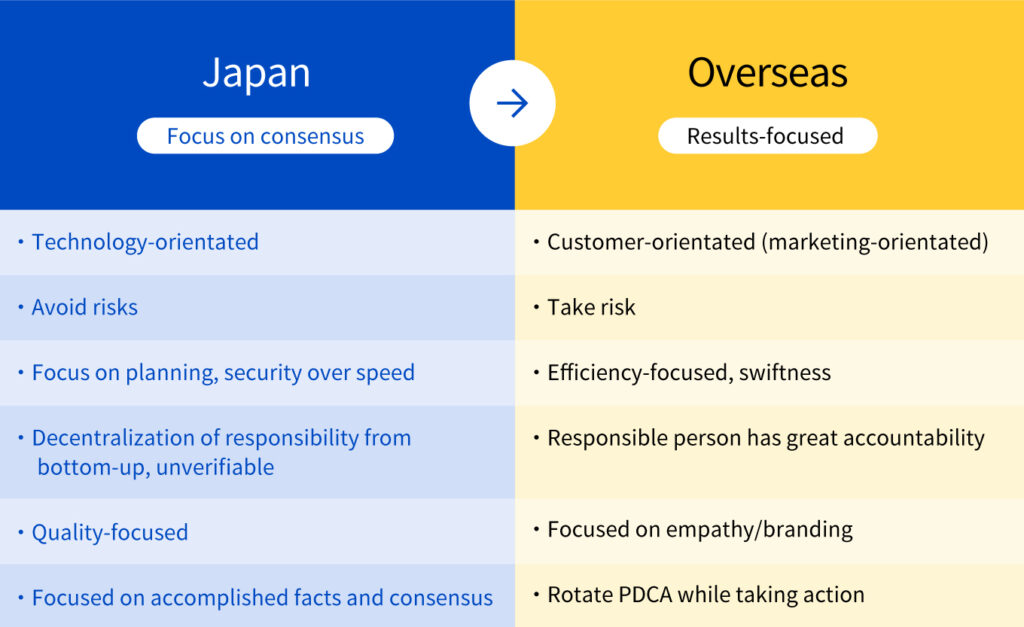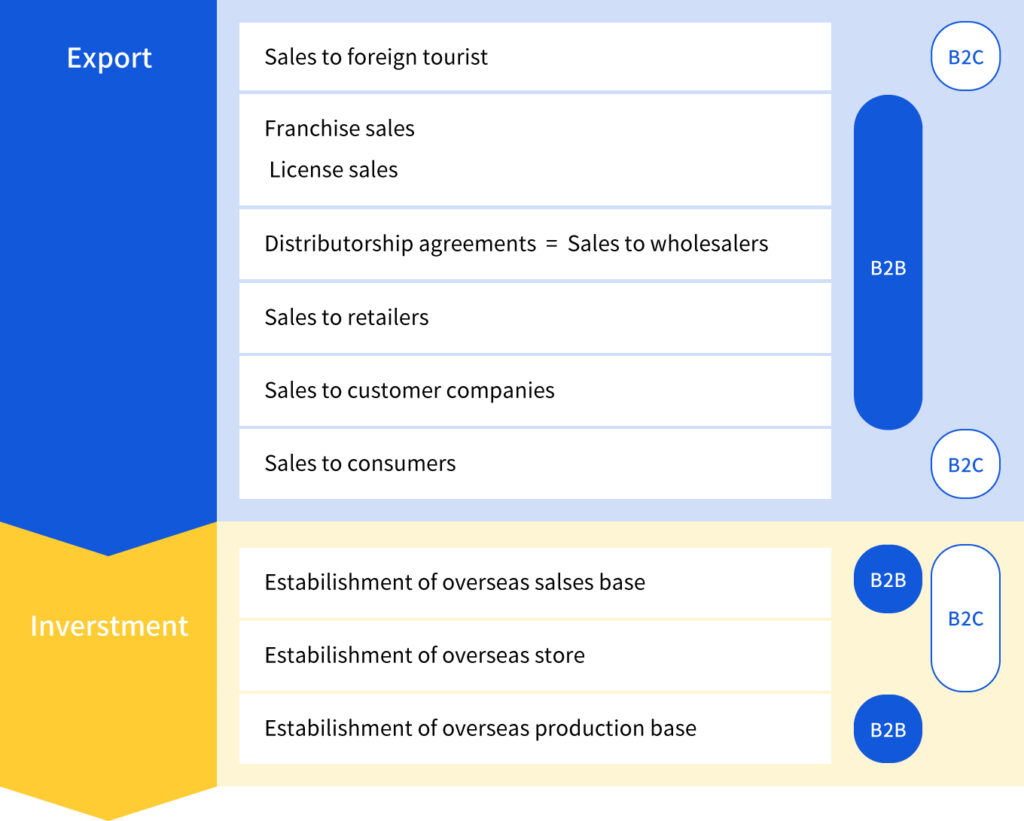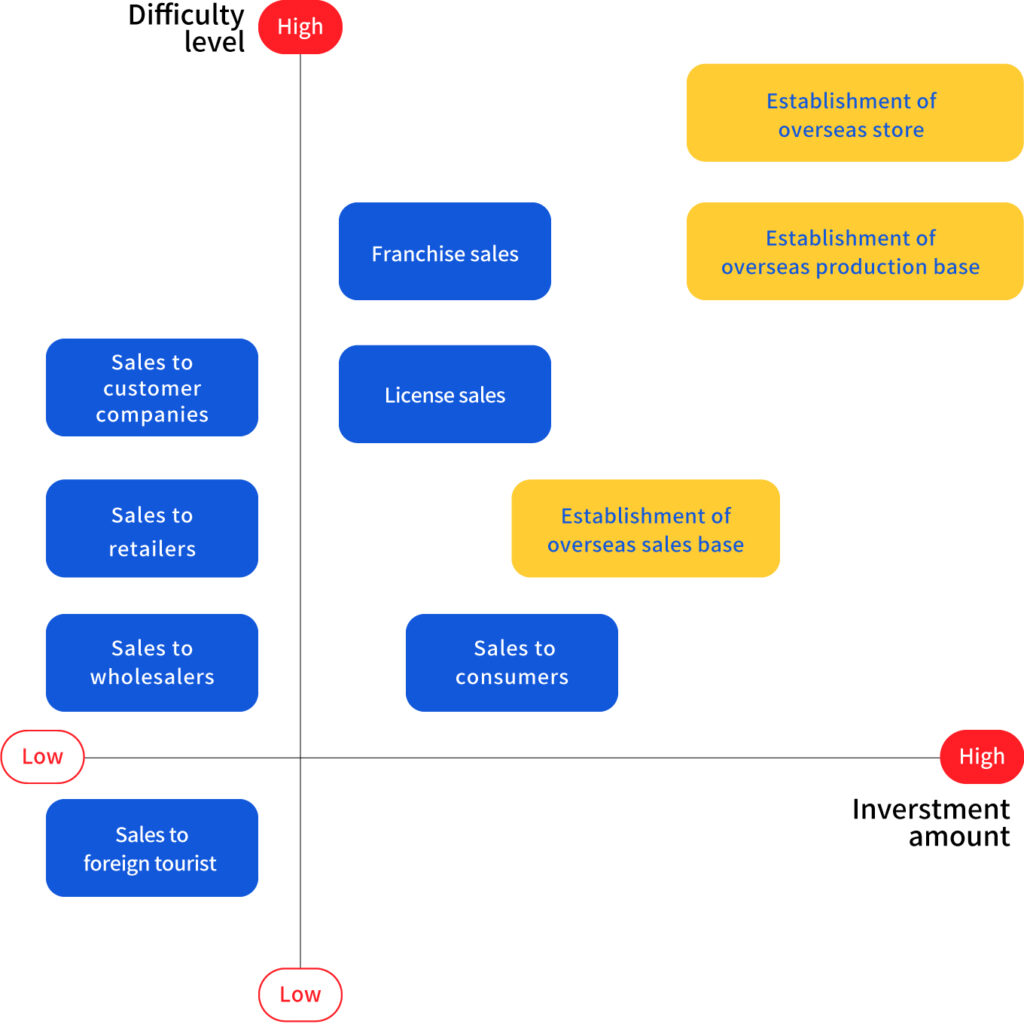Roadmap
There is a certain “method” to international expansion.
Paccloa has drawn up a roadmap for each step with hints to help you expand your business overseas for the first time. First, please read the item that concerns you the most.


Introduction
There is an undeniable excitement regarding the unknown that is the overseas market, however as soon as one embarks on the journey of international expansion, there are many mountains w e must climb, valleys we may get stuck in, and we may lose our way.
If you made up your mind that “I want to sell my products overseas too!” or “I want to set up a shop or factory overseas! but then missed your chance because you were unsure of the “method” to achieve your goal, it would be quite a shame. This section will explain about four things to know before embarking on international expansion.
・ Basic knowledge on international expansion
・ Types of international expansion
・ Levels of risk and difficulty by international expansion type
・ Benefits of independently achieving international expansion
First, please acquire basic knowledge on international expansion.
Basic knowledge on international expansion
There are both commonalities and differences between overseas countries and Japan. Naturally, we all share the same daily routine of eat, work, and sleep, however there are many differences regarding the way we engage in social life, our fundamental thinking, and so forth. Amongst these, there is a significant difference in regards to business customs between Japan and the rest of the world. Being aware of these differences in advance will help make your international expansion progress smoothly.

As shown above, when starting a new business, people in overseas countries tend to prefer to place emphasis on results and efficiency, and act swiftly. Authority is delegated to the individual person in charge, and risks are taken for the sake of return.
Even when undertaking a new endeavor, people overseas do not spend too much time on prior planning and research, rather first get started on their endeavor, then rotate the PDCA cycle (Plan→ Do → Check → Act), and correct their processes as required.
In countries outside of Japan, it is completely acceptable to take an approach of finding the answers to unknowns while on the go. The mindset of “no risk, no return” is deeply rooted.
Meanwhile, in Japan, we are not tolerant of taking risks or the possibility of failure so, although we understand the need to first take action, we don’t really have a culture of doing so as we prioritize caution.
We tend to focus on things such as “What should we do to minimize failure?” rather than“How can we have great success?”
For example, when expanding business aimed at overseas customers, unexpected challenges we have never faced in Japan frequently arise as “the norm.”
On such occasions, Japanese businesspeople tend to proceed passively based on their own convenience, rather than that of the overseas customer, and take an approach of monitoring the situation within the scope of maintaining the status quo. Potential overseas trade partners may become very frustrated due to the Japanese business tendencies of “not trying to reach a better destination together and not exhibiting the anticipated speed and response.”
As this example shows, there is a vast difference between the business customs of Japan versus the rest of the world, and this impacts all opportunities for international expansion. Unfortunately, if this difference is not appropriately addressed, successful international expansion will not be possible.
It is essential that you understand the differences between Japan and other countries, and, at the very least, do your best to adhere to the business customs of your target country. The effort to blend in is the effort to imagine what kind of frustration you are making the other party feel and the effort to be aware of your own “unawareness.”
Although Japanese companies express strong concern regarding taking business risks overseas, sometimes they are extremely defenseless, and there is an unbalance against the risks. If one wishes to avoid risk, one must first get to thoroughly know risks.
This includes knowing what type of risks exist overseas, how they arise, the maximum/minimum impact on your business’s Japan head office in the event of failure overseas, and how to avoid or mitigate risk.
It is only when you truly learn about risks and formulate the relevant countermeasures that you realize you were lumping all risks together as one and not being forward-thinking.
Businesspersons must be able to seamlessly switch modes between Japanese business customs and the customs of the target country, otherwise the speed of their international expansion will fall, and the action to break into the market will amount to a mere “seen-it-before” loose punch.
For example, if the enterprise hits a brick wall, some options may be lowering price, increasing technical strength, targeting the affluent population, inserting another company in the middle as a risk hedge, and creating English versions of their tools, however all of these punches will also fall short and be practically ineffective unless the company switches its business customs appropriately.
However, when a company does switch business customs, new scenery will become visible to it for the first time.
That scenery is only visible through the lens of accepted overseas business customs.
Perhaps the reason you were told the price of your product was too high is that there was no demand for your product in that market to begin with. Meanwhile, even without lowering price, if you change the application to one for which a local need does exist, or use different distribution channels, the target consumer will change, and your business may be triumphant over your competitors.
In regards to technical strength, it may not be a matter of increasing strength, rather that, while compromising with existing products, it is difficult to gain a position in the local market, therefore distributors may simply need a marketing hint to ensure your product sells.
Sales efforts aimed at the affluent are high-risk/high-return because if you succeed, the scale will be large, but customer acquisition requires hard work and money. Therefore, it may be better to carefully reopen the upper-middle-class zone as this could make it easier to secure stable profit and sustainable business as a valued partner.
If you insert another company as a risk hedge, the price of your product will undoubtedly increase. Then, if your product doesn’t sell, you are in a worse predicament than what you would have been without a risk hedge. Often it is the case that a simple translation of a Japanese company’s High context website into Low context English makes no sense to the web visitor whatsoever.
Becoming familiar with and learning about business norms overseas are prerequisites to success international expansion.
First, you must change the scenery you are looking at.
Only if you humbly continue learning and practicing overseas business customs will you be able to find your unique winning strategy and optimal solution entirely independently, appropriately, and with confidence.
Business customs differ between Japan and other countries…
I thought I understood this,
but maybe I was still looking at the same old scenery.
I’ve taken a straight punch already…
At Paccloa, we’ve seen lots of failed attempts, so we wanted to tell you about this first up.
But, don’t worry!
This roadmap is full of secrets to success and helpful essential tips. Perhaps you will start to see different scenery the more you read through our website content.
Is that so? That’s a relief.
Meanwhile, there are various types of international expansion, aren’t there?
I’ve “imported” parts from overseas before, so I simply thought selling to overseas was just a matter of “exporting”…
Types of international expansion

Broadly speaking, there are two types of international expansion; export and investment.
*If you import or outsource production, you are the buyer therefore, the other companies will do their best to please you. As we will explain later, intellectual property rights management is necessary, however establishment and continuation are not as difficult as new exports and investment.
The main forms of investment are establishment of sales bases, establishment of stores, and establishment of production bases. (Please see here also 4B Making overseas investments)
Export includes the below types: inbound, franchising/licensing agreements, and wholesale/retail/consumer-targeted sales.
Inbound
Generally-speaking, the first form of international expansion is “inbound”, which is trade within one’s own country, however this also includes an exporting element because the customer returns to their own country after purchasing a product.
Compared to full-blown export, inbound does not require cumbersome tasks such as adhering to export regulations and procedures, however foreign language skills and intercultural adaptation may be required.
What you must never forget is management of intellectual property. It is not necessarily the case that all customers who visit Japan for inbound purposes have good intentions.
After taking the product back to their country, sometimes people imitate a product’s design, logo, etc. and sell it. Such undesirable situations cannot be completely prevented, however at the very least, you should be sure to secure your product’s design and trademark rights in Japan.
Franchising Agreements/Licensing Agreements
This is not limited to export of goods, but also export of know-how and technology.
Even businesses that face a bottleneck in terms of transportation due to large or heavy products, cumbersome maintenance requirements making it difficult for exporting to be profitable, etc., can have success overseas by establishing technical licensing agreements allowing local partners to engage in production and sales.
If your business has a solid franchise package and headquarters function for stores and services operating in Japan, one option other than investing your own capital in the target country could be establishing a franchising agreement with an overseas company and earning income in the form of royalties.
Sales to Wholesalers, Retailers, and Consumers
These are the three common types of exporting. (Apart from these three, we could also include direct selling to corporate clients).
There is direct trading with wholesalers, retailers, and consumers, as well as inserting distributors or agents in between.
Sales to wholesalers, retailers, and corporate clients are known as “B2B” business, while sales to consumers are referred to as “B2C” business.
Launching a cross-border e-commerce site and directly selling to overseas consumers would be a B2C exporting business.
I see!
Please tell us about the levels of risk and difficulty, too!
Levels of risk and difficulty by international expansion type

Generally speaking, investments such as establishment of an overseas base, have greater risk than exporting goods due to the high investment outlay required.
Difficulty-wise, sales aimed at local overseas companies are the most difficult, and not proportional to sales aimed at local Japanese-owned businesses. The level of difficulty differs depending on whether you must completely abide by overseas rules or if the client accepts Japanese (familiar) business customs despite being located overseas.
Next, we will introduce four questions to broadly determine the risk and difficulty levels of international business.
First, let’s consider the below three questions.
- Which country are the customers of your product/service from?
- Where is the company receiving payment from customers based?
- In which country does the company mentioned in (2) pay tax?
If the answer to the above three questions are all “overseas” than the level of difficultly will be relatively high. You need to be aware that overseas business differs entirely to domestic business.
However, the difficulty level is lower if the customer is Japanese.
If you answered “Japan” more times than “Overseas” to the above questions, please also consider the below question.
- Is it difficult to newly enter the business field (within Japan) due to stringent distribution restraints and laws/regulations?
If the answer is likely to be “difficult,” than often the situation is similar overseas, so the difficultly level changes from low to high.
Here are some concrete examples.
Selling interior knick-knacks to inbound customers
“Overseas” x “Japan” x “Japan” (low difficulty/low risk)
For example, in the case of an interior variety store selling goods to inbound customers (visitors to Japan), a Japanese company would receive money from foreign nationals visiting Japan and pay tax in Japan. The answers to the above 3 questions would be “Overseas,” “Japan,” and “Japan,” making the “Japan” ratio high, therefore the level of difficulty would be low.
Let’s consider Question 4 just in case. The entry barrier to running a variety store is low, therefore as long as you have no difficulty serving foreign customers who travel to Japan, both the difficulty level and risk will be low.
Opening a Japanese restaurant in Vietnam
“Overseas” x “Overseas” x “Overseas” (high difficulty/high risk)
What about opening a Japanese restaurant in Vietnam?
The restaurant run by the “Japanese company’s” Vietnamese subsidiary would sell to Vietnamese customers and pay tax in Vietnam. All 3 answers to the key questions would be “Overseas,” therefore careful strategy planning would be required as a business with high difficulty.
Exporting machine parts to a Japanese-owned company in the U.S.
“Overseas” (Japan) x “Japan” x “Japan” (low difficulty/low risk)
When selling machine parts to a Japanese-owned company in the U.S. with which you do business in Japan also, while it is trading with an overseas company, Japanese business customs are accepted to a certain extent, therefore both the level of difficulty and risk are low.
Even if difficulties unique to doing business overseas arise (compliance with regulations/standards, document inadequacies, purchase order oversights, defective part exchange, etc.), if the head offices of both companies are based in Japan, one could anticipate an environment that will ultimately facilitate a solution.
While the language of communication would be English, generally speaking, business inquiries, quotations, and payment often proceed smoothly.
Exporting medical equipment to the Middle East
“Overseas” x “Japan” x “Japan” (high difficulty/medium risk)
What about if you were exporting medical equipment from Japan to countries in the Middle East?
This would be a case of “Overseas” x “Japan” x “Japan” because a Japanese company would export products to an overseas company, receive payment, and pay tax in Japan, therefore it seems relatively easy.
However, if we check Question 4 just in case, we find that distribution restrictions and laws regarding medical equipment are stringent in Japan, and the barrier to new entry can be considered high. As such, we can predict that the level of difficulty for such business would likely be high rather than low.
In reality, there would be a need to conduct advance investigations into local import restrictions on medical equipment, overseas PL insurance, exit strategies for distributor agreements in the Middle East (resolution is not easy), and so forth. As such, although this is a case of exporting, it would require unexpected time and money, therefore can be considered a highly difficult endeavor.
However, if we look at it in reverse, the high entry barrier applies to the competition also, so this could be interpreted as an opportunity, which is often used as a springboard for international expansion.
Another company in our industry has apparently begun international expansion. We want to start exporting our product too and, although still in the process of conducting research, want to sell directly to overseas customers if possible.
But, I wonder if we should get a local consultant or trading company to help us first…
Benefits of Independently Achieving International Expansion
Even in the case of SMEs, there are many benefits to be gained from achieving international expansion on your own.
Ultimately, only companies with the ability to take the initiative and be independent will be able to continue doing business overseas. This is because, the very process of starting from scratch and becoming strong enough to independently and proactively take on international expansion forms the foundation of being able to battle on in overseas markets too.
Requesting a trading company or other sales/expansion support company to gather information, find new customers or engage in local negotiations is one efficient method of accelerating international expansion.
However, to achieve stable, ongoing international expansion, it is important not to leave tasks such as these up to a third party because they are cumbersome, but also having the ability to do them yourself, if need be.
This is because, only by physically going to the target country, directly seeing and speaking with locals, enduring the process of trial and error and making decisions independently based on an understanding of the risks can you acquire firsthand insight on the benefits of expanding overseas.
7 benefits of taking the initiative and achieving international expansion independently:
- More precise and swift decision-making by ascertaining firsthand information on the local market and customers. For example,
- Identifying industries and markets for which prices, players and rules are yet to be established and perceive opportunities to participate in these with your own unique business model
- Predict the future of your competition from competitors’ movements and reflect this into the direction and development of your company’s products.
- Actively and strategically verify those “key points” that you wouldn’t pick up on through secondary information alone. Also,
- Know-how on the process of international expansion will become your company’s intellectual property and enable you to independently export and invest in other countries also.
- More choices regarding sales routes to suit product/country-specific characteristics, such as direct trade by yourself or indirect trade via another company, etc.
- Facing unforeseen circumstances and having to make swift decisions through directly doing business with local companies, you will always have a backup framework in place (e.g. plan B, plan C, etc.) and swift PDCA management, consequently making you stronger against recessions.
Moving forward, if an SME attempting to meet overseas demand has the strength to promote international expansion independently, it will have the advantage over its competitors, and be able to change crises into once-in-a-lifetime chances.
I thought international expansion was a case of “just giving it a go” if you had the drive and motivation!! (LOL)
That will never work!
You need to gain proper knowledge on international expansion and proceed according to a plan!!
But where do I begin?
How should I go about it? I have absolutely no clue…
The answer is simple!
There is a set method to international expansion.
Let’s start by taking a look at each step of the roadmap for Paccloa-Style International Expansion.
First you need to conduct a study to assess the feasibility of your company’s international expansion.

